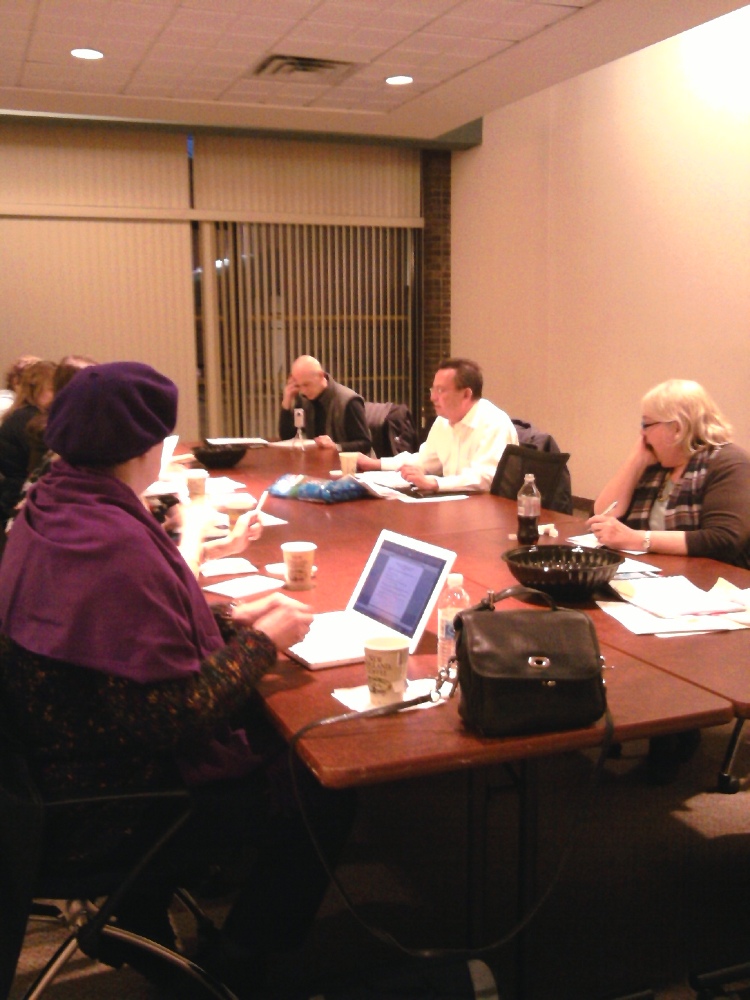CDAG has questions, comments for master planners on river view sheds, public art

Members of the Central Delaware Advocacy Group said at Thursday night’s meeting that they need to know the specific height of the mid-rise developments master planners want along some parts of the Central Delaware Waterfront.
Similarly, they want details on what kind of businesses would be allowed in areas zoned light industrial.
The discussion was a continuation of one that started last month. Talking points were based on a list of praise, questions and criticisms compiled by community group Neighbors Allied for the Best Riverfront, commonly called NABR (pronounced “neighbor”), which has representatives on CDAG. One of them, Mary Stumpf, led the CDAG discussion. NABR gathered feedback from its membership and CDAG members and from waterfront community residents to create the document.
The earlier discussion started with the elements of the plan that people really love, including the parks interspersed every half-mile along the waterfront, the mixed use development and reuse of existing buildings, piers and industrial remnants, the extension of the street grid and the restoration of wetland habitat.
Thursday’s meeting focused more on items that CDAG or neighborhood residents found unclear or that flat-out worried them. It also touched on things that they think the plan should include that are either not in it now, or that they believe should be stated stronger.
Stumpf said some are concerned that development outlined for some areas of the still-in-the-works master plan could block river views along a significant portion of Delaware Avenue. One such place is the boat basin near South Street. It is now being dredged so that more boats can dock there, and Stumpf said this is an idea that was universally embraced. People also like the plan to link South Street to the waterfront with a pedestrian bridge. But some believe the hubub of South Street should end in a more tranquil, green space rather than in “six to 8 story” buildings, she said.
“When you drive down Delaware Avenue, you’re not going to be able to see the river,” said member Tom Potts.
Chairman Steve Weixler said Society Hill residents have concerns about a plan to link the waterfront to Society Hill and Old City with a large structure that would slope gradually from the riverfront back to the neighborhoods and be landscaped in a park-like fashion. Between the structure and the development around it, some current views of the river would be cut off, he said.
“We don’t want to be walled off from the river by new development, no matter how good the new development is,” he said.
Several members also expressed concern that a large structure like that would cast a dark shadow on Delaware Avenue below, creating a scary place that people would avoid. Members want to know if skylights could be added to allow light down below, or if in some cases, smaller, less dense pedestrian bridges could be used.
Member Joe Schiavo suggested that the best way to know whether or not views would be impacted is to ask the planners for a specific height of building they had in mind, in stories or in feet. Weixler suggested feet would be better, because a luxury apartment building could be built with few stories but very high ceilings.
One theme that was woven through the discussion was a desire for the Central Delaware to be at least as much for local residents as it is for visitors. Potts wondered if two hotels were really needed along the waterfront. Member Jim Moss said that CDAG should focus only on whether it wanted two hotels, because no developer would build something without first considering the demand at the location.
Stumpf said that people have suggested working in a dog park or two, perhaps in the green areas near highway off-ramps.
Weixler said the master plan process seems to be a great way to require public art at both private development and public places. Public art rules that apply to other parts of the city should be written into the master plan and affiliated zoning, he said.
Members liked this idea, and said that allowing local neighborhoods to have a say about the artwork, and also the nature of the parks in their area, would help continue the unique flavor of each neighborhood down to the river’s edge.
The light industrial development is slated mostly for the northern part of the plan, and Potts, of the New Kensington Community Development Corporation, said residents in his area, want the plan to lay out specifically what business can and cannot be placed there. Light industrial is way too broad a term, member Rene Goodwin agreed.
Weixler said that translating everything in the plan into zoning requirements is a very important and tricky part of the process. One thing he wants an answer on is how the varying widths of the waterfront setback will be set into zoning.
Weixler said he will spend the weekend compiling the group’s questions and comments, then forward them to Marilyn Jordan Taylor, chair of the Delaware River Waterfront Corporation’s planning committee and PennDesign Dean. Having the questions and comments sets the stage for two workshop meetings between DRWC and CDAG next week, one on the northern half of the Central Delaware, and one on the southern half. These meetings are not open to the public. CDAG’s regularly scheduled Feb. 10 meeting has been cancelled.
Weixler said that after DRWC answers CDAG’s questions and responds to the comments, CDAG members will have a better idea of what the draft of the master plan is going to say. From there, he said, CDAG can begin to advocate to the DRWC board, city council and the planning commission in favor of those parts it agrees with. And CDAG will also lobby for any changes it thinks are necessary, he said.
Reach the reporter at kgates@planphilly.com
WHYY is your source for fact-based, in-depth journalism and information. As a nonprofit organization, we rely on financial support from readers like you. Please give today.



